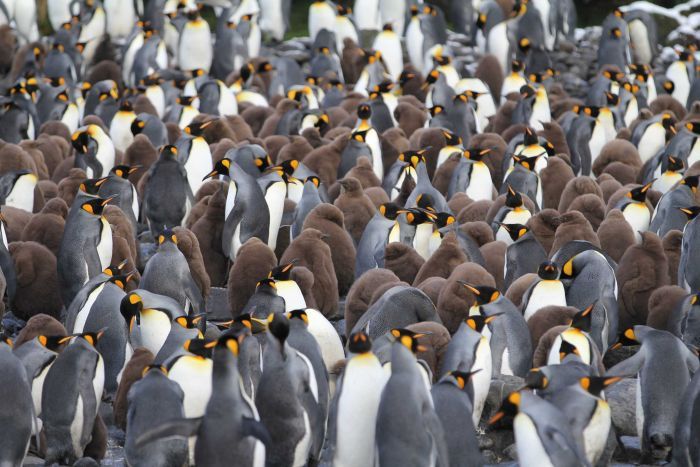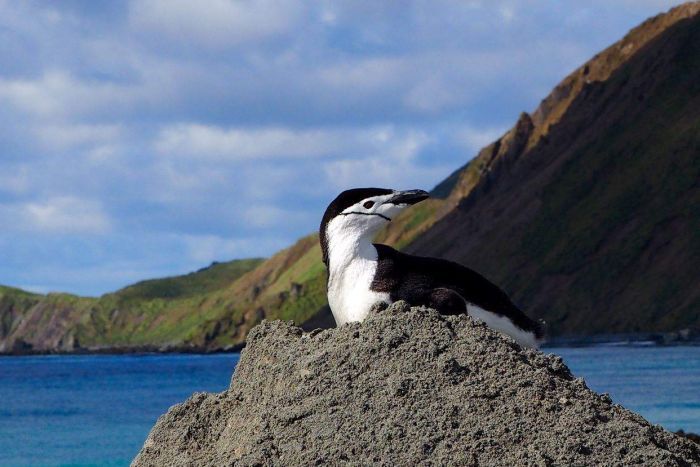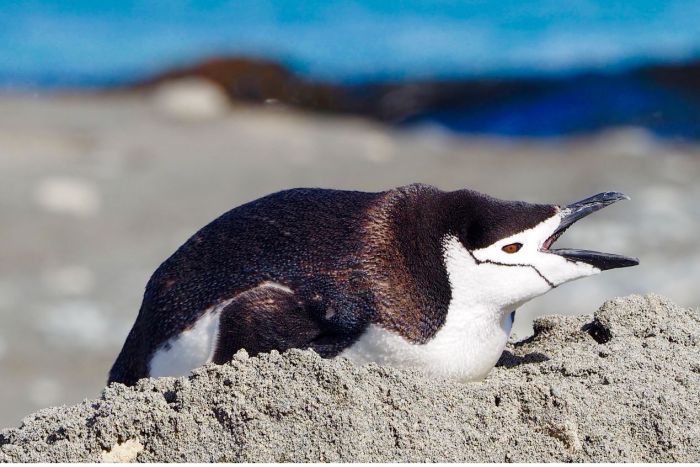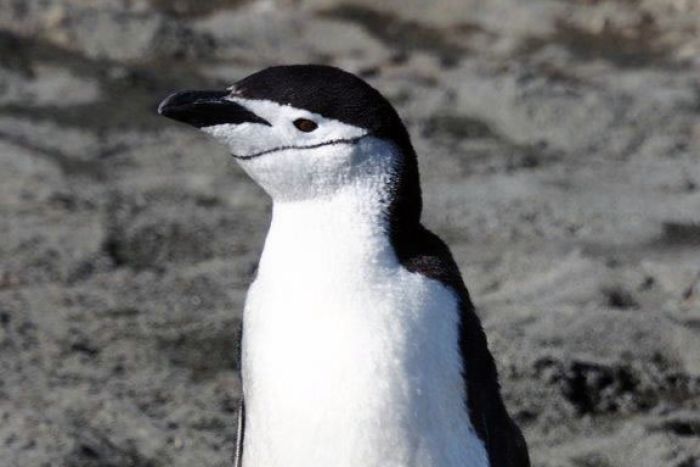Chinstrap penguin makes rare 1500-kilometre trip to Macquarie Island
Updated
What makes a tiny penguin set out on an epic journey through a vast ocean with seemingly little hope of returning home in one piece?
Antarctic researchers are not actually sure, but when one little chinstrap penguin made a very rare appearance on remote Macquarie Island recently there was great excitement.
The chinstraps are cousins of the more common adelie penguins, but the nearest colony of chinstraps is about 1,500 kilometres south of Macquarie Island
There have only been five chinstrap sightings on "Macca" since 2013, and 44 since 1953.
Australian Antarctic Division penguin biologist Barbara Wienecke said most chinstrap populations live on the Antarctic Peninsula, South Orkney Islands and South Georgia.
"Macquarie Island is certainly a paradise for penguins, but the species that usually breed there do not include the chinstraps," she said.
"It is always exciting when people see birds that are a long, long way from what is considered their normal range by biologists, but clearly, what do we know?"
"A bird is called a 'vagrant' once they are several hundred kilometres out of the range from what they are usually expected, and the nearest colony of chinstraps would be about 1,500 kilometres south of Macquarie Island, so it is one heck of a distance to swim."
 Photo:
King penguins and other species breed on Macquarie Island, but not chinstraps. (ABC News: Dave Hudspeth)
Photo:
King penguins and other species breed on Macquarie Island, but not chinstraps. (ABC News: Dave Hudspeth)
Dr Wienecke said when penguins were swimming around the ocean they did not usually travel on a north-south trajectory and it was not clear why this one turned up so far from home.
"It is always difficult to figure out birds' motivations," she said.
"The problem is, particularly for the young birds, we don't really know how far they actually disperse.
"Most [penguins] will probably stay within Antarctic waters but every now and then, possibly driven by the wanderlust, one simply takes a different trajectory from everybody else."
Penguin may simply be exploring
Dr Wienecke said is was not likely the penguin simply got lost.
"Birds are extremely good navigators unless they have some some sort of genetic abnormality that would prevent them from navigating properly, which is possible but probably extremely rare," she said.
"So young birds who have got no need to be anywhere near their breeding colonies, they usually have several years when they can explore the southern ocean and sometimes they literally just take a turn and go elsewhere, where possibly not too many have gone before."
Dr Wienecke said it was unfortunate that such random visits afford little opportunity for scientists to learn more about the species' travel habits.
"It would be fantastic if we had a program in place and equipment on the island to put a little satellite tag on the bird and actually see where it would go when it leaves Macquarie Island, but it is impossible to plan for such events, because you don't know when they are going to happen," she said.
She said it was not as simple as popping a spare tracking device on the bird and seeing where it wanders.
"I mean, we can't just go out and harass birds just because we think it's a wonderful idea — we do need to have properly assessed and evaluated research programs in place, we do need ethics committees approvals — there is a whole raft of documents that need to be in place before we can actually do something like that," she said.
One of these things is not like the others
 Photo:
Then it was off to the beach to meet some local kings and a gentoo penguins. (Supplied: George Brettingham-Moore AAD)
Photo:
Then it was off to the beach to meet some local kings and a gentoo penguins. (Supplied: George Brettingham-Moore AAD)
While the wandering chinstrap penguin is visiting his relatives on Macquarie Island he does not quite blend in with the crowd.
"The other penguins most certainly realise that he is different and, depending on the mood of the day, he could become harassed," Dr Wienecke said.
"I suspect he would try to stay away from the rest of the penguins, but if he tried to enter one of the colonies he would certainly at the very least get a few weird glances.
"I remember working in an adelie penguin colony and nearly fell off my rock when a little chinstrap started to waddle up.
 Photo:
Macquarie Island paparazzi (aka "expeditioners") were excited about the visiting chinstrap penguin. (Supplied: Esther Rodewald AAD)
Photo:
Macquarie Island paparazzi (aka "expeditioners") were excited about the visiting chinstrap penguin. (Supplied: Esther Rodewald AAD)
"It was extraordinary because, size-wise the adelies and chinstraps are quite similar, and even the colouration's really similar, but they most certainly recognised immediately that this bird was different and some of them chased it and others just stopped in their tracks and sort of looked around and thought 'What on earth is he doing here?'."
Dr Wienecke said while it might seem like a hopeless quest for the little penguin to return home safely, his chances of survival on the return trip were actually quite good.
"There is plenty of food out there at the moment and chinstraps are not really specialised feeders," she said.
"He would be able to find a lot of small fish and a lot of varieties of krill out there, and I think he is going to have a good life ahead of him."
And if he manages to avoid the predators in the Southern Ocean, the adventurous chinstrap will have quite a tale to tell.
 Photo:
The chinstrap penguin surveying his surroundings from a dirt pile. (Supplied: Kim Klista AAD)
Photo:
The chinstrap penguin surveying his surroundings from a dirt pile. (Supplied: Kim Klista AAD)
Topics: marine-biology, conservation, animals, human-interest, macquarie-island-7151
First posted










